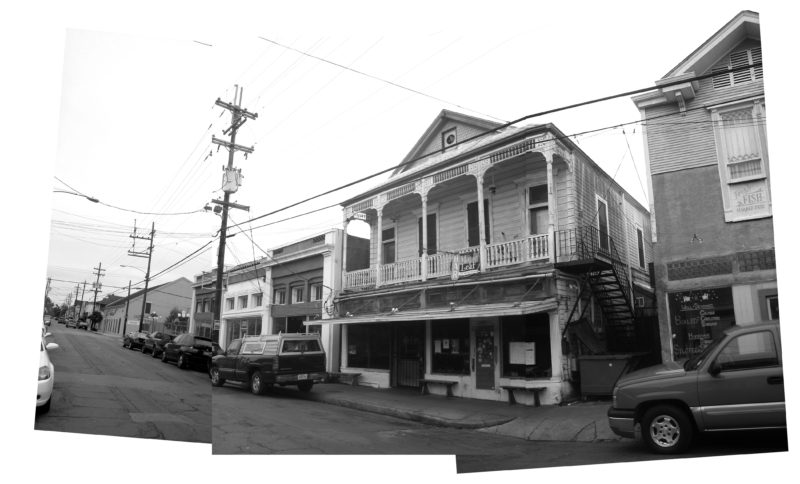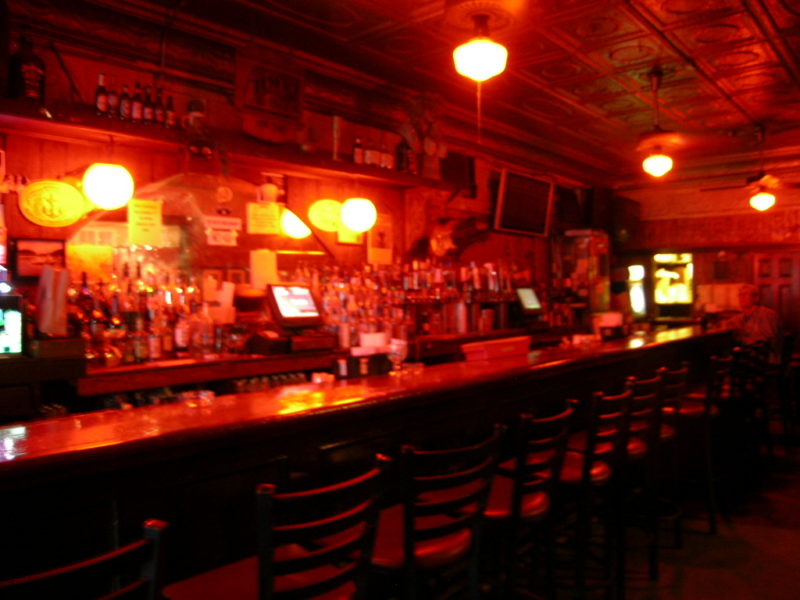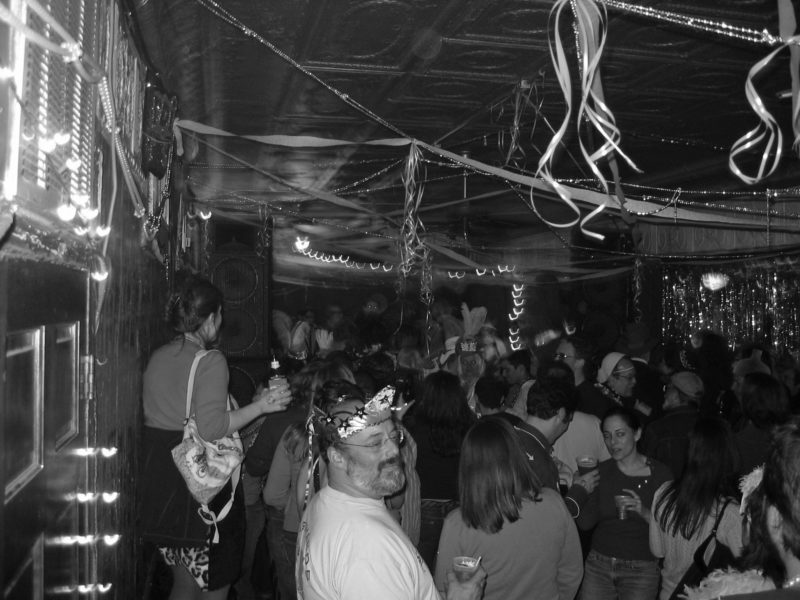
The unassuming exterior of the Maple Leaf Bar. Photo by Bethany Rogers.
Located at 8316 Oak Street in the Uptown New Orleans area, the Maple Leaf Bar continues to thrive since its opening on February 24, 1974 (Rosenberg, Diana. “June is an anniversary month for the practically-legendary Sunday afternoon Maple Leaf Bar poetry reading series.” The Wavelength. June 1985). Primarily, the bar is known as a music club with a reputation for hosting classic New Orleans and Louisiana roots bands (Spera, Keith. “Long Live The ‘Leaf; For 30 years, the Maple Leaf Bar has been at the heart and roots of the Uptown music scene.” Times-Picayune, February 6, 2004, Lagniappe page 24). The Maple Leaf is also recognized for embracing local culture with weekly poetry readings (Larson, Susan. “Poets Do the Maple Leaf Rag.” Times-Picayune, June 11, 1989, Section E-7) and other events including games such as “Jeopardy” (Rose, Christopher. “In ‘Jeopardy’ Every Day.” Times-Picayune, April 1, 1993, Section E-1). The bar owes its success to its multiple owners, especially John Parsons and Hank Staples for their various ideas and endeavors (Spera, Keith. “Long Live The ‘Leaf.” Times-Picayune, February 6, 2004, Lagniappe page 24).

The dimly lit front bar. Photo by Bethany Rogers.
The six original owners, William Odom, Tom Bethall, Jim Stratton, Carl Brown, Judy Cooper, and John Parsons, did not foresee the Maple Leaf Bar becoming the “granddaddy” of Uptown music venues (Hannusch, Jeff. “Maple Leaf Chaulks Up 15 Years of Hometown Music.” Times-Picayune, February 24, 1989). The bar was originally called “The Maple Leaf Rag Time Bar and Chess Club,” because of Parsons’ talent for the game. Chessboards and chess pieces were provided for interested guests, as well as darts and a jukebox. It was intended to be an intellectual, yet informal, gathering space for patrons to come get a drink. Occasionally local jazz music would be played, but for the most part would be an intimate, quiet, place to converse with friends. In the first couple years after its opening, Parsons gradually started adding more weekly acts, making live music a staple for the place. Soon the Maple Leaf took the live music to its full potential, booking acts seven days a week. The owners were deemed “cultural missionaries” for the Uptown area, which at the time had not had a dependable live music scene (“Maple Leaf Bar.” Town of Carrollton News. April 2,1975. Ad. Pg 5).
The Maple Leaf Bar is the longest running Uptown music club and throughout its years hosted many local New Orleans and Louisiana bands (Spera, Keith. “Maple Leaf Turns 25.” Times Picayune, January 15, 1999, L-8). The Andrew Hall Society Jazz Band headlined the bar’s opening in February of 1974. Although Andrew Hall felt “real nervous” about the initial show, he and his band became attached to the bar and performed on Saturday nights for eight years (Spera, Keith. “Long Live The ‘Leaf.” Times-Picayune, February 6, 2004, Lagniappe page 24). In the beginning, the Maple Leaf hosted many traditional jazz musicians, many of which had not played in 20 years. Hall describes this time as, “the halcyon days of my music career. It wasn’t big money, but the Maple Leaf was a great atmosphere to work in” (Spera, Keith. “Long Live The ‘Leaf.” Times-Picayune, February 6, 2004, Lagniappe page 24). After eight years of hosting free performances by the Society Jazz Band, the owners decided to do away with them in order to fill the spot with more “amplified” bands that could attract large crowds willing to pay (Spera, Keith. “Long Live The ‘Leaf.” Times-Picayune, February 6, 2004, Lagniappe page 24). In the following years the Maple Leaf hosted, and in many cases continues to host, performances by a number of artists and groups including; James Booker, The Iguanas, Marcia Ball, Rockin’ Dopsie Sr. and Jr., The Subdudes, Rebirth Brass Band, and more recently Papa Grows Funk (Spera, Keith. “Long Live The ‘Leaf.” Times-Picayune, February 6, 2004, Lagniappe page 24). Cajun and zydeco music were nearly foreign to the area before the introduction of BeauSoleil, Clifton Chenier, and others (Spera, Keith. “Maple Leaf Turns 25.” Times Picayune, January 15, 1999, L-8).

Patrons fill the crowded dance floor. Photo by Bethany Rogers.
The abundance of music attracted dancers from the beginning. During the 1980’s a New Orleans local with a passion for two stepping, Harry Perret, resembled John Travolta in “Saturday Night Fever” as he made his entrance into the Maple Leaf on Thursdays (Behre, Patricia. “Dancing For a Lark.” Times-Picayune, February 16, 1986, Dixie-4). “I guess dancing is something I do religiously,” said Perret, who shared this religion with many other patrons (Behre, Patricia. “Dancing For a Lark.” Times-Picayune, February 16, 1986, Dixie-4). Columnist Patricia Behre describes the dance floor as a place where, “there are collisions, knees knock, and couples thud into each other from behind. Dancers spin out from their partners and get carried off by the crowd” (Behre, Patricia. “Dancing For a Lark.” Times-Picayune, February 16, 1986, Dixie-4).
In 1979, Franz Heldner, a local artist and bar regular, suggested that the Maple Leaf have weekly poetry readings (Rosenberg, Diana. “June is an anniversary month for the practically-legendary Sunday afternoon Maple Leaf Bar poetry reading series.” The Wavelength. June 1985). The late Everette Maddox and Robert Stock gave the first readings, both being enthusiastic customers as well as part of the early team organizers which also included Maxine Cassin and Yorke Corbin. Readings occasionally took place on the stage at the front of the building, but most commonly occurred on the rear, plant-filled patio where Maple Leaf gets its name. This laid back atmosphere is the setting for the “longest continuously running reading series in the city” of New Orleans (Rosenberg, Diana. “June is an anniversary month for the practically-legendary Sunday afternoon Maple Leaf Bar poetry reading series.” The Wavelength. June 1985).
In the June 1985 issue of Wavelength Magazine, there is an article dedicated to the 6-year anniversary of the “practically-legendary Sunday afternoon Maple Leaf poetry reading series” (Rosenberg, Diana. “June is an anniversary month for the practically-legendary Sunday afternoon Maple Leaf Bar poetry reading series.” The Wavelength. June 1985). Writer Diana Rosenberg describes it as being both “indigenous and cosmopolitan.” She also mentions that during readings, it often became chaotic outside the bar with occasional Oak Street float parades and children running in and out of the building so “regulars knew to expect the unexpected” (Rosenberg, Diana. “June is an anniversary month for the practically-legendary Sunday afternoon Maple Leaf Bar poetry reading series.” The Wavelength. June 1985). Consequently, the participating audience comprised of well-educated, local residents with enthusiasm about the kind of media they were contributing to the community. Maple Leaf’s poetry readings excluded and charged no one, which propelled the reader series to acquire national recognition. The Maple Leaf Bar has hosted poets from throughout the United States as well as its first international reader, “the prominent Canadian novelist David Adams Richards” (Rosenberg, Diana. “June is an anniversary month for the practically-legendary Sunday afternoon Maple Leaf Bar poetry reading series.” The Wavelength. June 1985).
The Maple Leaf’s weekly poetry readings first became significant in 1980 with the publishing of the “Maple Leaf Rag: An Anthology of New Orleans Poetry” based on the first season of readings, edited by Cassin, Corbin and Maddox, and published by the New Orleans Poetry Journal Press, given that it “remains the only comprehensive anthology of contemporary New Orleans poetry” (Rosenberg, Diana. “June is an anniversary month for the practically-legendary Sunday afternoon Maple Leaf Bar poetry reading series.” The Wavelength. June 1985).
Originally, the Maple Leaf had six owners. Over the years ownership changed and as of 2000 belonged to three men; John Parsons (one of the original owners), and co-owners Carl Brown Jr. and Hank Staples (Spera, Keith. “Maple Leaf Turns 25.” Times Picayune, January 15, 1999, L-8). Parsons and Staples are attributed with the bulk of influence and contributions given by owners.
Parsons is attributed for shaping the Maple Leaf’s reputation as a relaxed and welcoming venue with local music. Parsons’ business partner Staples speaks of “the effect John has on music in New Orleans…he has an unequaled track record for finding bands who have done really well” (Spera, Keith. “Long Live The ‘Leaf.” Times-Picayune, February 6, 2004, Lagniappe page 24). Not only did he introduce Cajun music to the area, but is also responsible for the success of groups such as The Iguanas and The Subdudes (Spera, Keith. “Long Live The ‘Leaf.” Times-Picayune, February 6, 2004, Lagniappe page 24).
Staples’ innovation tended to be more practical than creative like his partner Parsons. During the peak Mardi Gras and Jazz Fest weeks, Staples maximized the club’s profits by introducing late night “sunrise” shows in which local “jam bands” played all night. Also, Staples enhanced the bar in order to serve more people at a faster rate (Spera, Keith. “Long Live The ‘Leaf.” Times-Picayune, February 6, 2004, Lagniappe page 24).
Due to the profits generated by late night shows and faster bar service, Staples renovated much of the club. The electricity, described as terrifying, was brought up to code. The bathrooms, once marking, “an act of courage for a woman to use them” were also redone. However, some things will never be renovated according to Staples, including the pressed tin walls and gas lamp fixtures (Spera, Keith. “Long Live The ‘Leaf.” Times-Picayune, February 6, 2004, Lagniappe page 24).
Staples is also responsible for the creation of the “Jeopardy” game at the Maple Leaf. Before he became part owner, Staples worked behind the bar, including day shifts. “The worst job you can have here is to be the day bartender,” he said in 1993. To ease his boredom, Staples created the rules. Players paid one dollar to play and the bar matched the pool up to ten dollars. In the “Final Jeopardy” round players wrote their questions on the napkins and whoever won got to keep the pot (Rose, Christopher. “In ‘Jeopardy’ Every Day.” Times-Picayune, April 1, 1993, Section E-1).
 NOLAbeings
Multimedia artist Claire Bangser created NOLAbeings as a portrait-based story project that marries...
NOLAbeings
Multimedia artist Claire Bangser created NOLAbeings as a portrait-based story project that marries...
 Data corner: Adobe Suite (create a PDF, social media graphic, presentation, edit a photo and video
Data corner is where you go to work with analytics and top tech skills. It takes on everything from PERL and SQL to Canva and Sprout Social.
Data corner: Adobe Suite (create a PDF, social media graphic, presentation, edit a photo and video
Data corner is where you go to work with analytics and top tech skills. It takes on everything from PERL and SQL to Canva and Sprout Social.
